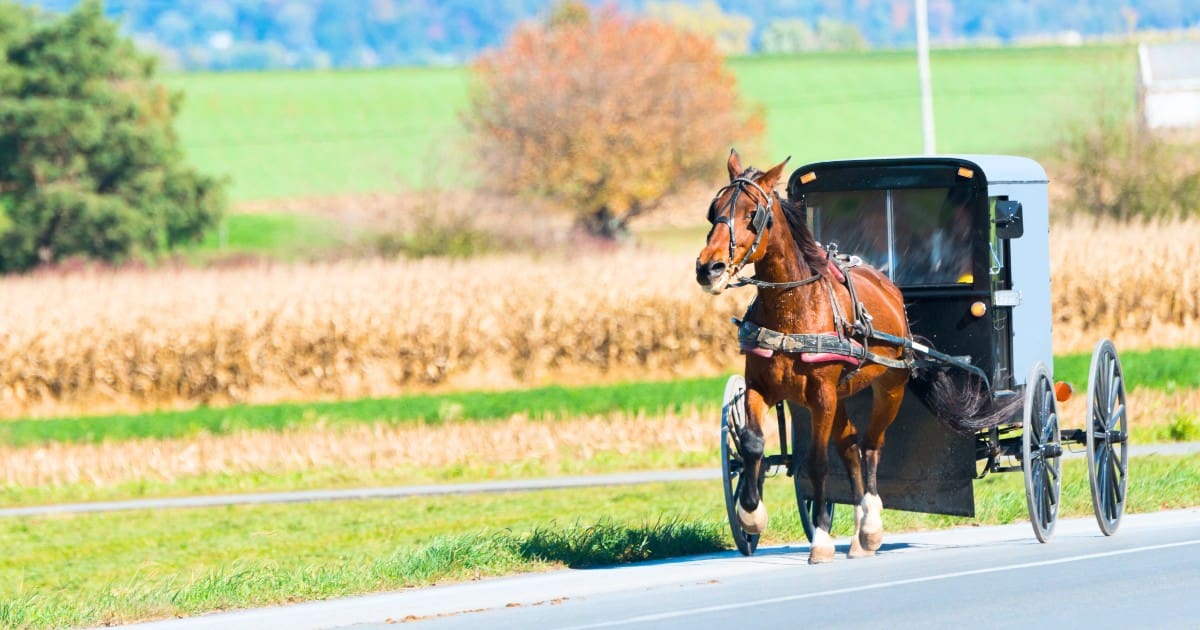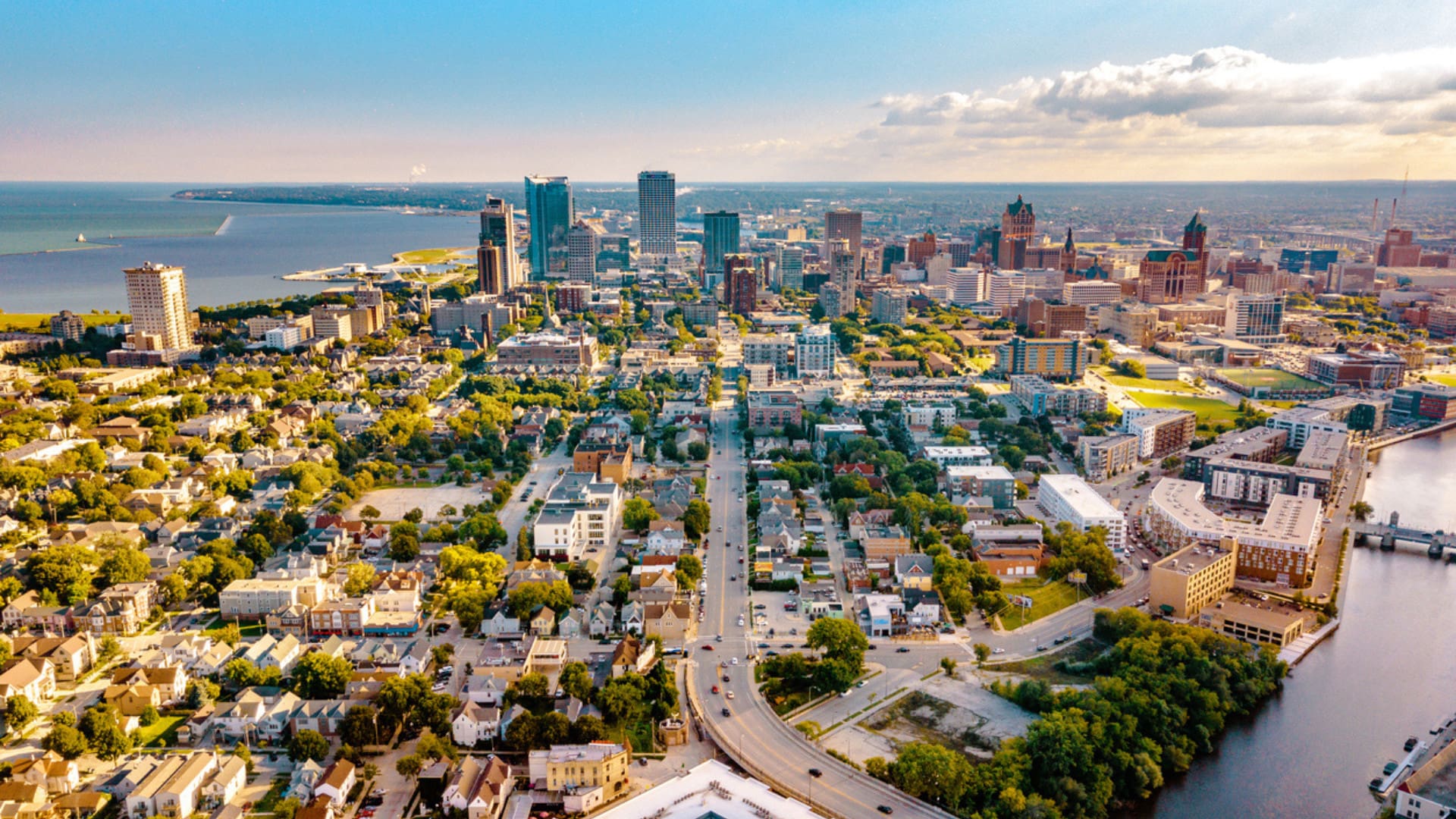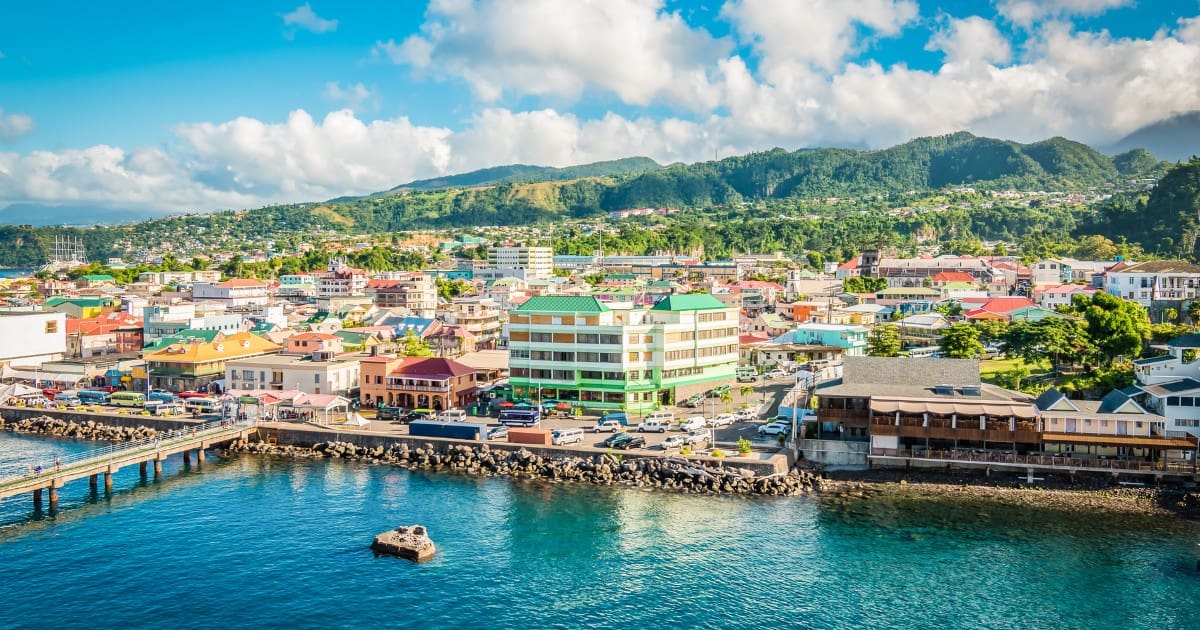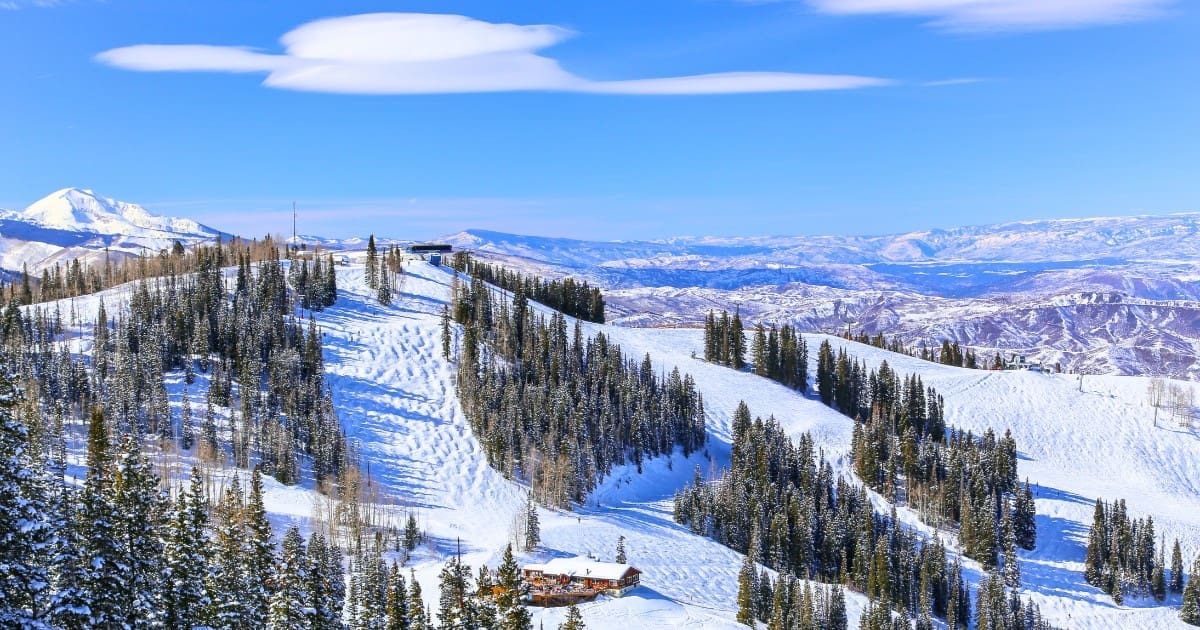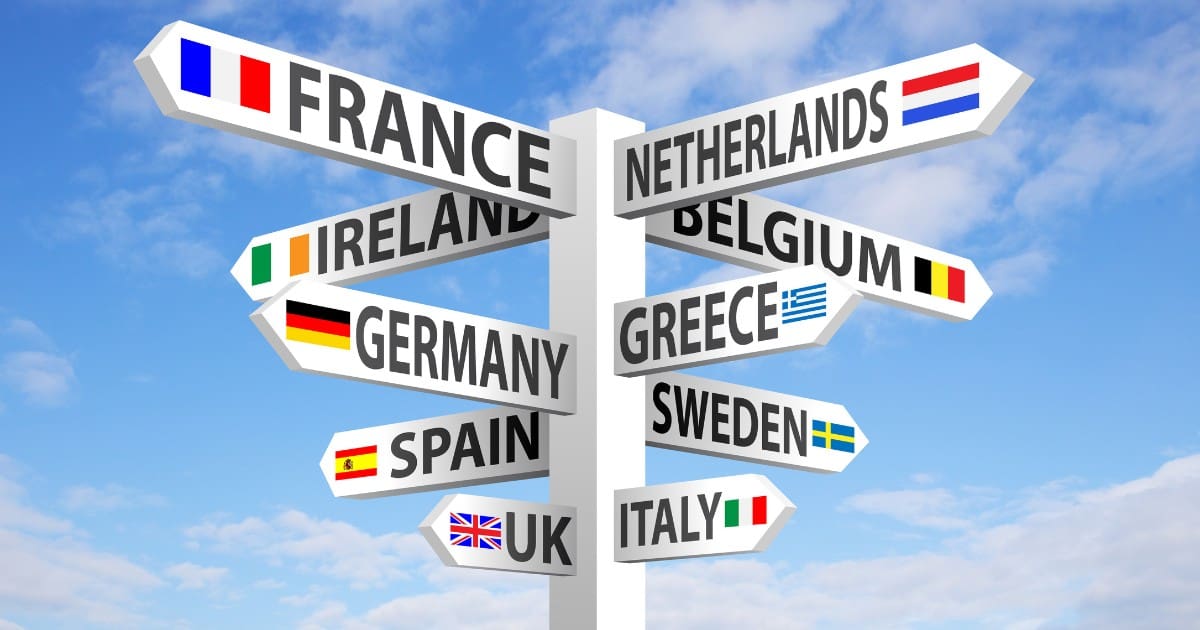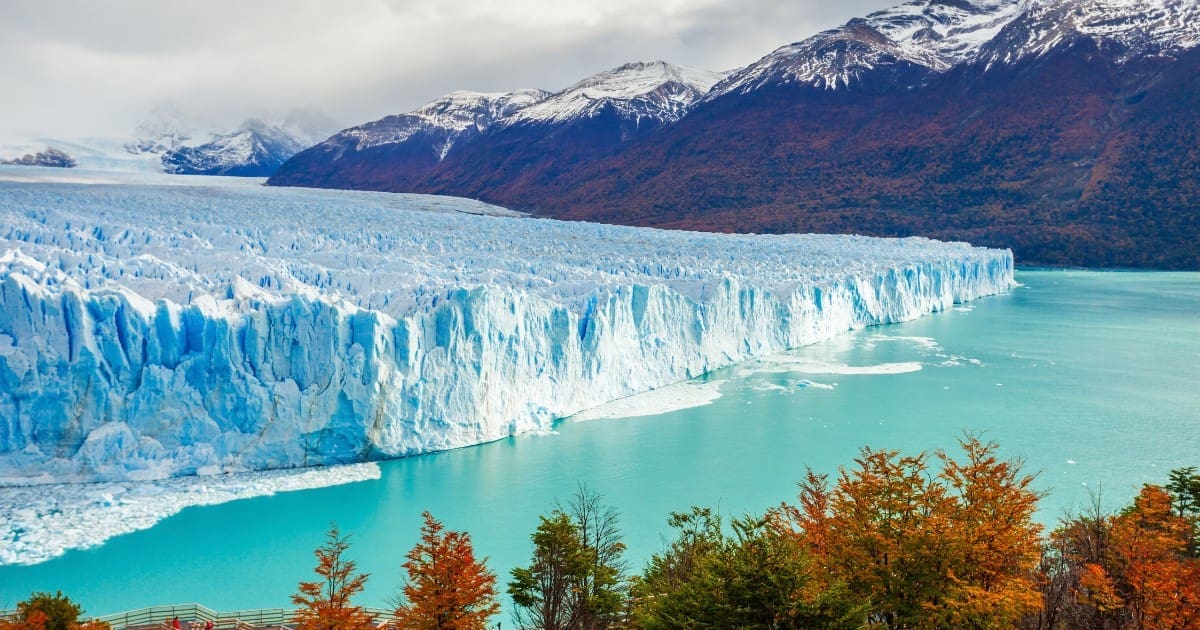Algeria is opening its doors wider than ever to travelers in 2024. This North African destination is ready to show off its mix of ancient history, landscapes, and culture. With new visa policies and improved tourism infrastructure, it’s easier than ever to explore the best places to visit in Algeria.
Did you know Algeria is the largest country in Africa? It’s true! With over 1,600 kilometers of Mediterranean coastline, vast Saharan deserts, and cities full of Roman ruins, there’s so much to discover. In 2024, Algeria aims to welcome over 4.5 million visitors, a big jump from previous years. Let’s get to know the top destinations travelers should go to in Algeria!
1. Algiers: Algeria’s White City by the Sea

Algiers, the capital city, is where history and modernity blend seamlessly, creating a unique atmosphere that’s hard to resist. Here’s a table showing some of the cool things you can see in Algiers:
| Attraction | What to See | Why It’s Awesome |
|---|---|---|
| Kasbah | Ottoman palaces, mosques | UNESCO World Heritage site, 16th-century architecture |
| Martyrs’ Memorial | 92-meter monument, museum | Great city views, learn about independence struggle |
| Hamma Garden | 3,000+ plant species, zoo | Relaxing nature spot, see exotic plants and animals |
| Bardo Museum | Prehistoric artifacts, mosaics | Learn about Algeria’s ancient history |
| Notre Dame d’Afrique | 19th-century basilica | Beautiful architecture, panoramic city views |
Walk Through the Old Kasbah
The Kasbah of Algiers is a must-travel UNESCO World Heritage site that dates back to the 16th century and is full of stories. As you walk through the narrow, winding streets, it feels like being in a maze of history.
The buildings here are painted white, giving the Kasbah its nickname “The White City.” You’ll see beautiful mosques with intricate designs, old Ottoman palaces, and tiny shops selling everything from spices to handmade crafts.
One of the most interesting spots is the Ketchaoua Mosque. Built in 1612, it’s been both a mosque and a cathedral over the years. The mix of Islamic and Christian architecture is really something special.
See the Big Martyrs’ Memorial
The Martyrs’ Memorial, or Maqam Echahid as the locals call it, is a must-see. This massive monument stands 92 meters tall and looks like three giant palm leaves reaching for the sky. It honors the people who died fighting for Algeria’s independence.
Take an elevator to the top for an amazing view of the whole city, with the blue Mediterranean Sea in the distance. It’s a great spot for taking photos, so don’t forget your camera!
At the base of the monument, there’s a museum that tells the story of Algeria’s fight for freedom. It’s a bit heavy, but it’s a great way to learn about the country’s recent history.
Enjoy the Pretty Hamma Garden
For a break from the city buzz, head to the Jardin d’Essai du Hamma. This huge botanical garden covers 58 hectares (that’s about 140 football fields!) and has over 3,000 different types of plants.
You can spend hours walking along shady paths, admiring tall palm trees and colorful flowers. There’s even a section with plants from all over the world, like bamboo from Asia and eucalyptus from Australia.
The Hamma Garden has been around since 1832, making it older than your great-grandparents! It’s not just plants either – there’s a small zoo where you can see some interesting animals native to Algeria, like Barbary macaques (they’re monkeys) and fennec foxes with their big ears.
2. Oran: Fun City on the Beach

Oran, Algeria’s second-largest city, is known for its beaches, music scene, and interesting mix of cultures. It’s a dynamic coastal city that’s sure to leave an impression on visitors of Algeria. Here’s a quick comparison of some of Oran’s top attractions:
| Attraction | Best For | What You’ll See |
|---|---|---|
| Fort Santa Cruz | History buffs, view seekers | Old fortress, city panorama |
| Raï music cafes | Music lovers, night owls | Live performances, local culture |
| Plage Madagh | Beach lovers, swimmers | Clear water, soft sand |
| Les Andalouses | Families, water sports fans | Long coastline, beach activities |
| Ahmed Wahby Museum | Art and music enthusiasts | Modern art, Raï music history |
Climb the Fort of Santa Cruz
One of the first things to do in Oran is visit the Fort of Santa Cruz. This old fortress sits on top of a mountain overlooking the city and the sea, which was built way back in the 1500s by the Spanish, who ruled Oran at the time.
The climb up is a bit tough but totally worth it. From the top, you can see the whole city spread out below. The view of the Mediterranean is stunning – it seems to go on forever! Inside the fort, you can explore old cannons, walk along the battlements, and imagine what it must have been like to defend the city from this spot.
There’s a small chapel inside the fort called the Chapel of Santa Cruz. It’s still used for special ceremonies today. Many locals come here to make wishes, especially brides-to-be who hope for good luck in their marriages.
Listen to Special Raï Music
One of the coolest things about Oran is that it’s the birthplace of Raï music. Raï is a type of Algerian folk music that’s super popular all over North Africa, which started in the 1920s and became a big international hit in the 1980s.
You can experience Raï music firsthand at local cafés. The music has a catchy beat that makes you want to dance, and the singers pour their hearts into every word. Even if you can’t understand the Arabic lyrics, you can feel the emotion in the music.
If you’re interested in learning more about Raï, check out the Ahmed Wahby National Museum of Modern Art. They have a whole section dedicated to the history of this unique musical style. You can see old instruments, photos of famous Raï singers, and even listen to some classic tracks.
Swim at Nice Beaches
Oran is famous for its beautiful beaches, and there’s plenty of time to soak up the sun. Plage Madagh, about 40 kilometers west of the city, is a favorite. The water is so clear you can see your toes in the sand even when you’re chest-deep!
Closer to the city, there’s Les Andalouses beach. It’s a long stretch of sandy coastline that’s perfect for walks. You’ll see families picnicking, kids building sandcastles, and even some brave souls trying out water sports like jet skiing.
One great thing about the beaches in Oran is the food. There are lots of little restaurants and cafes along the shore serving fresh seafood. Try “calamars à la plancha” – grilled squid with lemon and garlic. It’s delicious!
3. Constantine: Amazing City of Bridges

Constantine is unlike anywhere else in Algeria! It’s called the “City of Bridges” because it’s built on a rocky plateau with deep gorges, and there are seven big bridges connecting different parts of the city.
Here’s a table comparing some of Constantine’s top sights:
| Attraction | Age | What’s Special | Best Time to Visit |
|---|---|---|---|
| Sidi M’Cid Bridge | Built in 1912 | 175m high, great views | Sunset for amazing photos |
| Salah Bey Bridge | Opened in 2014 | Modern design, lit up at night | After dark to see the lights |
| Emir Abdelkader Mosque | Completed in 1994 | Huge size, beautiful architecture | During non-prayer times for tours |
| Cirta Museum | Building from 1930s, artifacts much older | Roman mosaics, ancient artifacts | Mornings when it’s less crowded |
| Palace of Ahmed Bey | Built 1825-1835 | Ottoman architecture, painted ceilings | Midday to see the colors in good light |
Look at Cool Bridges Over Deep Valleys
The bridges of Constantine are seriously impressive. The most famous one is called Sidi M’Cid, and it’s 175 meters above the Rhumel River gorge. Walking across it might make your heart race a little, but the view is totally worth it!
Another bridge to check out is the Salah Bey, also known as the “Flying Bridge.” It’s a modern suspension bridge that looks super cool next to the older stone bridges. At night, it’s lit up with colorful lights, making it look like something out of a sci-fi movie.
One interesting thing is how each bridge in Constantine has its own personality. Some are old and made of stone, while others are new and sleek. They all have different stories too. For example, the Sidi Rached bridge was built in 1912 and has 27 arches!
Visit the Beautiful Emir Abdelkader Mosque
After all that bridge excitement, a visit to the Emir Abdelkader Mosque is a must. It’s one of the biggest mosques in Algeria and can hold up to 20,000 people! The mosque is pretty new – it was finished in 1994 – but it’s built in a traditional style with some modern twists.
The mosque has two tall minarets that are 107 meters high. That’s like a 30-story building! Inside, you’ll see beautiful carpets, intricate tile work, and huge chandeliers. Even if you’re not religious, it’s worth visiting just to see the amazing architecture.
One cool thing about Emir Abdelkader Mosque is that it’s not just for praying. There’s also a library with lots of books about Islamic history and culture and an art gallery with beautiful calligraphy and paintings.
Learn History at the Cirta Museum
To learn more about Constantine’s long history, head to the Cirta Museum. Cirta was the name of the city in Roman times, and this museum is full of artifacts from that period and even earlier.
You’ll see ancient coins, pottery, and even some really old skeletons! But the real stars are the mosaics. These are like big pictures made out of tiny colored stones. The Romans were really good at making them, and some of the ones in the museum are huge and super detailed.
The museum also has stuff from more recent times, like traditional Algerian clothes and jewelry. You’ll learn that Constantine has been an important city for thousands of years, and lots of different people have lived here over time.
4. Timgad: Old Roman City in the Mountains

Let’s talk about Timgad, an amazing place to visit in Algeria. It’s an old Roman city hidden in the Aurès Mountains. Imagine walking down streets that people used over 2,000 years ago—pretty wild, right?
Here’s a fun table that compares some of the things you can see at Timgad:
| Thing to See | What It Is | Why It’s Cool | When It Was Built |
|---|---|---|---|
| Decumanus Maximus | Main street | You can walk on a 2,000-year-old road | Around 100 AD |
| Arch of Trajan | Big stone arch | It’s as tall as a 3-story building | Around 100 AD |
| Forum | City center | Where Romans hung out and shopped | Around 100 AD |
| Theatre | Ancient playhouse | Romans watched shows here | 160-200 AD |
| Library | Old book place | One of the few we know about in Roman cities | Around 200 AD |
Walk on Streets from Long Ago
Timgad is so well-kept that some people call it the “Pompeii of North Africa.” The Romans built it around 100 AD, and they were super organized about it.
They laid out the streets in a perfect grid, like a giant checkerboard. The main street is called Decumanus Maximus, which is just a fancy way of saying “big east-west road.”
When you’re there, look down at the ground. You might see marks from chariot wheels in the stones that seem like the Romans just left yesterday. You can check out old houses, shops, and even public bathrooms. Yeah, the Romans had those too!
One thing that’s really neat is how much of the city is still standing. In some places of Timgad, the walls are taller than a grown-up. You can walk into old buildings and imagine what they looked like when they were full of people in togas going about their day.
See the Big Arch of Trajan
At one end of the main street, there’s this huge arch called the Arch of Trajan. It’s about as tall as a three-story building! The Romans built it to honor Emperor Trajan, who started the city. It’s made of big stone blocks and has all sorts of carvings on it.
Walking under the arch is pretty exciting. Think about all the people who’ve walked through it over the years! Roman soldiers, traders, kids going to school – they all passed under this same arch. The carvings on it tell stories about Roman battles and everyday life.
Find Old Things in the Museum
After you’ve walked around the ruins, head to the museum. It’s right there at Timgad, and it’s full of cool stuff they’ve dug up from the city. You’ll see jewelry that Roman ladies wore, dishes they ate from, and even toys that kids played with!
The best part of the museum, in my opinion, is the mosaics. These are like giant puzzles made of tiny colored stones.
The Romans used those mosaics to decorate their floors, and some of them are huge! They show all sorts of things – animals, gods, and scenes from daily life. The colors are still bright after all this time.
5. Djemila: Roman Ruins on Hilltops

One of the best places to visit in Algeria is Djemila. Djemila is another old Roman city, but it’s different from Timgad in a fun way. The Romans built Djemila on hills, which made things tricky for them. But they figured it out, and now we get to see how clever they were!
Here’s a table that shows some of the cool things in Djemila:
| Place | What It Was For | What You Can See | When It Was Built |
|---|---|---|---|
| Forum | City center | Open space with columns | 2nd century AD |
| Arch of Caracalla | Honor the emperor | Big arch with carvings | 216 AD |
| House of Europe | Rich person’s home | Beautiful mosaic floors | 4th-5th century AD |
| Great Baths | Public bathhouse | Rooms for hot and cold baths | 2nd-3rd century AD |
| Christian Basilica | Church | Altar and baptismal font | 4th-5th century AD |
Explore Old Buildings on Hills
Walking around Djemila is like being on a roller coaster, but slower and with more old stones. The city goes up and down the hills, with buildings on different levels. The Romans used flat areas called terraces to build important stuff like temples and shops.
In the middle of it all is the forum. Think of it like an ancient town square. This is where people would meet, gossip, and buy things. Around the forum, you can see the remains of temples, big important buildings called basilicas, and little shops.
One of the coolest things in Djemila is the Arch of Caracalla. They built it in 216 AD for a visit from the emperor. It’s still standing and has lots of detailed carvings on it. Looking at it, you can tell the Romans were really good at making things last!
Look at Pretty Floor Pictures (Mosaics)
Djemila is famous for its mosaics. These are like floor paintings made of tiny stones. Many of them are still right where the Romans put them, which is pretty amazing when you think about how old they are.
There’s this one house called the House of Europe that shows a story from Roman myths about a princess named Europa and a god named Zeus who turned into a bull. The colors are still bright, and it almost looks like it could start moving!
Another place to visit in Algeria with awesome mosaics is the Baptistery. This was a Christian building, and its floor is covered in patterns and symbols. It’s interesting because it shows how the city changed from believing in Roman gods to becoming Christian.
Learn About Old Life in the Museum
After you’ve walked around outside, head to the museum. It’s full of things they found in Djemila that were too delicate to leave outside. There are more mosaics here, and they’re some of the best ones!
The museum tells the story of how Djemila changed over time. It started as a place for Roman soldiers, but it grew into a big, busy city. Later, it became an important Christian town. You can see how people’s lives changed by looking at the stuff in the museum.
6. Tassili n’Ajjer: Rock Art in the Desert
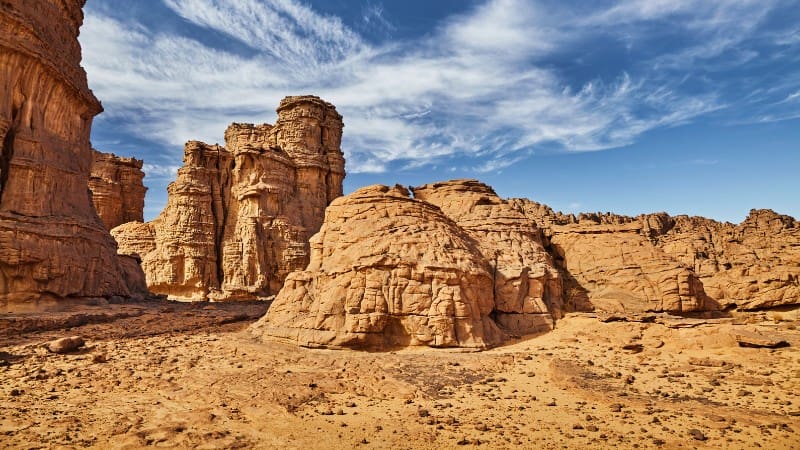
Let’s talk about a place that’s like nothing else in Algeria – Tassili n’Ajjer. It’s way out in the Sahara Desert, and it’s full of wonderful rock paintings and weird-looking rocks. Imagine a huge outdoor art gallery that’s thousands of years old!
Here’s a table that shows some cool things about Tassili n’Ajjer:
| Thing to See | What It Is | Why It’s Special | How Old It Is |
|---|---|---|---|
| Round Head paintings | Rock art | Shows people with round heads | 8,000-6,000 years old |
| Cattle Period art | Rock art | Shows when people had lots of cows | 5,000-4,000 years old |
| “Crying Cow” arch | Rock formation | Looks like a cow’s head | Millions of years old |
| Tuareg camps | Desert homes | See how people live in the Sahara | Modern day |
| Desert plants | Tough plants | Learn which ones you can eat | Various ages |
See Very Old Cave Paintings
Some of the rock art in Tassili n’Ajjer was made more than 10,000 years ago! That’s way before the pyramids in Egypt or even writing was invented. The paintings show all sorts of animals that used to live in the area when it wasn’t a desert. You can see elephants, giraffes, and even hippos!
The people who made these paintings were really good artists. They used different colors and drew their animals in a way that makes them look like they’re moving.
It’s funny to think that the Sahara used to be green and full of animals. The old cave paintings help us understand how the climate changed over time.
Walk Among Weird-Shaped Rocks
The landscape in Tassili n’Ajjer is out of this world. Over millions of years, wind and sand have carved the rocks into the strangest shapes. Some look like giant mushrooms, others like castles or animals. Walking around Tassili n’Ajjer feels like being on another planet!
These rock formations are called “rock forests” because they stick up out of the sand like trees. Some of them are really tall – taller than a five-story building! The rocks create natural shelters, which is probably why ancient people chose to live and make art here.
There’s this one famous rock called the “Crying Cow.” It’s a big rock arch that looks a bit like a cow’s head. Another cool one is the “Arch of Tamrit,” which is a natural stone bridge. Standing under these huge rocks makes you feel tiny!
Meet People Who Live in the Desert
Even though Tassili n’Ajjer looks empty, people still live there. The Tuareg people have called this desert home for hundreds of years. They know how to find water, what plants you can eat, and how to navigate using the stars.
Tuareg people are famous for their blue clothes and silver jewelry. The men often wear a special turban that can be up to 8 meters long! They wrap it around their heads to protect them from the sun and sand. Tuareg women, like most Algerian women, are known for being strong and independent. They often run businesses and own property.
If you’re lucky, you might get to hear some Tuareg music. They play a special kind of guitar called an imzad. It only has one string, but in the hands of a skilled player, it can make beautiful music that tells stories about desert life.
7. M’Zab Valley: Special Desert Towns
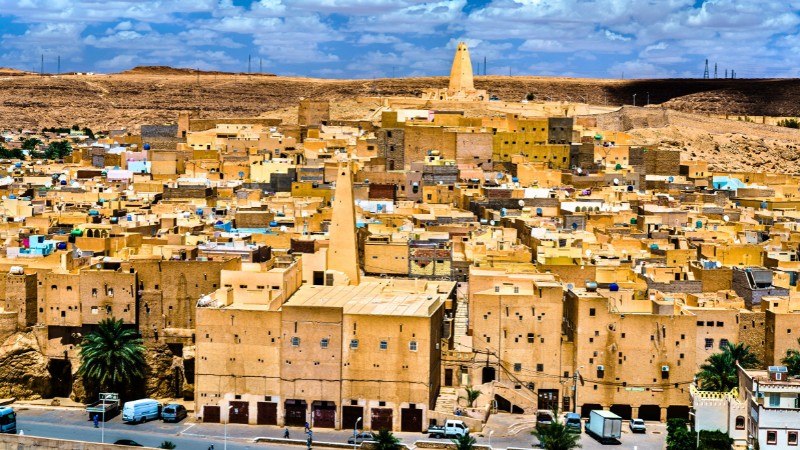
Now, let’s check out a place to visit in Algeria that’s totally different from anywhere else – the M’Zab Valley. It’s like someone dropped five little towns right in the middle of the desert. These towns are super old and were built in a really smart way to deal with the hot, dry weather.
Here’s a table that shows some interesting things about the M’Zab Valley:
| Town Name | What’s Special | Year It Was Built | Famous For |
|---|---|---|---|
| Ghardaia | Biggest town | 1053 | Central market, carpets |
| Melika | Oldest town | 1012 | Ancient mosque |
| Beni Isguen | Most traditional | 1347 | Strict rules for visitors |
| Bounoura | High location | 1046 | Great views of the valley |
| El Atteuf | Oldest mosque | 1012 | Sidi Brahim mosque |
See Five Old Towns Built for Protection
The towns in the M’Zab Valley are called the Pentapolis. That’s just a fancy word meaning “five cities.” They were built between 1012 and 1350, which is during the time when knights and castles were a big deal in Europe. The biggest and most famous of these towns is called Ghardaia.
Each town is built on top of a hill and has high walls around it. This was to protect the people from desert raiders and sandstorms.
In the middle of each town is a big mosque with a tall minaret. The houses are built in circles around the mosque, kind of like a spiral. From above, it looks like a big target!
The streets in Pentapolis are really narrow and twisty. This isn’t because the builders got lost – it’s actually really smart! The narrow streets create shade and help keep the air cool acting as natural air conditioning for the whole town.
Shop at Busy Markets in Ghardaia
Ghardaia is the main town in the M’Zab Valley, and it has some amazing Algerian markets. The biggest one is right in the center of town. It’s covered to keep out the sun, and it’s full of all sorts of cool stuff. You can buy spices that smell amazing, dates that taste like candy, and carpets with beautiful patterns.
One of the most famous things to buy in Ghardaia is a special kind of carpet. The Algerian women of the M’Zab Valley are really good at weaving, and their carpets are known all over Algeria. Some of them take months to make!
If you visit the market, make sure to try some dates. The M’Zab Valley is famous for its date palms, and they grow all kinds.
Some are soft and gooey, others are drier and taste a bit like caramel. The locals say eating a date from the M’Zab Valley is like eating a piece of sunshine!
Learn How Algerian People Live in the Desert
The people who live in the M’Zab Valley are called Mozabites. They’ve lived in this tough desert environment for over a thousand years, and they’ve come up with some clever ways to survive like collecting and saving water.
Each house has a system to catch rainwater and store it underground. This might not seem like a big deal, but in a place where it only rains a few days a year, every drop counts! The Mozabites also dig deep wells and use a smart irrigation system to water their gardens.
Speaking of gardens, the Mozabites are really good at growing food in the desert. They have these amazing palm groves just outside the towns. Under the tall palm trees, they grow all sorts of fruits and vegetables. It’s like a green oasis in the middle of the sandy desert!
8. Tamanrasset: Town Near Big Mountains
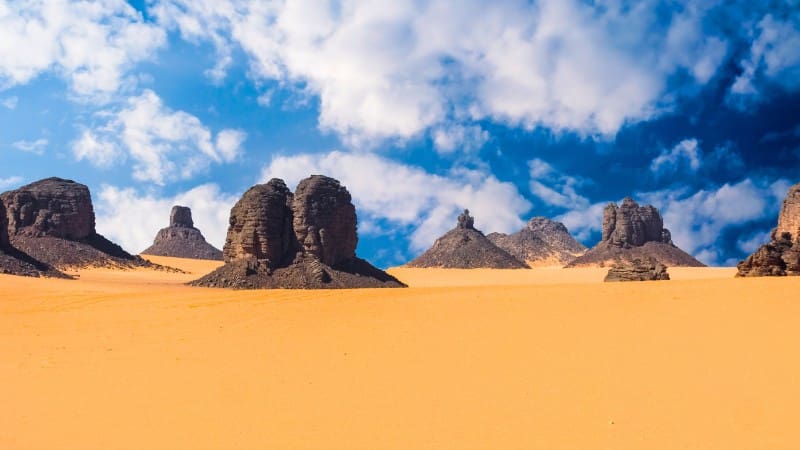
Tamanrasset is a place that’s way down south in Algeria. It’s like an oasis in the middle of the Sahara Desert, surrounded by these huge mountains called the Hoggar.
Imagine a town where camels walk down the street next to cars and where you can see the stars so clearly at night it feels like you could reach out and touch them!
Here’s a table that shows some interesting things about Tamanrasset and the surrounding area:
| Thing to See | What It Is | Why It’s Special | Best Time to Visit |
|---|---|---|---|
| Mount Tahat | Highest mountain in Algeria | 2,908 meters tall | October to April (cooler) |
| Tin Hinan Tomb | Ancient queen’s burial place | Over 1,500 years old | Any time (it’s indoors) |
| Hoggar Mountains | Volcanic mountain range | Unique rock formations | Early morning for best views |
| Tamanrasset Market | Local marketplace | Buy Tuareg crafts | Early morning (before it gets hot) |
| Assekrem Plateau | High desert plateau | Amazing sunrise views | Just before dawn |
Hike in Ahaggar National Park
Ahaggar National Park is right next to Tamanrasset, and it’s a place that’ll make your jaw drop. The park is huge – about the size of New York State!
Ahaggar National Park is full of these big, pointy mountains that look like they’re from another planet. Some of them are actually old volcanoes that haven’t erupted in a really long time.
One of the best things to do in Ahaggar National Park is go for a hike. Some trails take you up into the mountains, and the views are amazing.
Here, you might see animals you’ve never seen before, like Dama gazelles or Barbary sheep. These animals are really good at climbing and can run up the steep mountain sides like it’s nothing!
If you’re lucky, you might spot a fennec fox. These little guys have huge ears that make them look like Yoda from Star Wars.
Fennec foxes’ big ears help them stay cool in the hot desert and hear bugs moving underground. They’re super cute, but they’re also really shy, so you have to be quiet if you want to see one.
Climb the Special Assekrem Mountain
Assekrem is a mountain that’s very important to the local Tuareg people. It’s not the tallest mountain in the area, but it might be the most beautiful. The name “Assekrem” means “the end of the world” in the Tuareg language, and when you see the view from the top, you’ll understand why.
To get to the top of Assekrem, you have to drive on a bumpy road and then hike for a bit. But trust me, it’s worth it! The best time to go is early in the morning to watch the sunrise. As the sun comes up, it turns the desert and mountains into all sorts of crazy colors – pink, purple, orange, and gold.
At the top of Assekrem, there’s a small building called a hermitage. It was built by a French explorer named Charles de Foucauld who lived there over 100 years ago. You can visit the hermitage and imagine what it must have been like to live all alone on top of a mountain in the middle of the desert.
See How Desert People Live Today
Sure, Tamanrasset is a place for tourists, but it’s also home to lots of Tuareg people. The Tuareg have lived in the Sahara Desert for hundreds of years, and they have some interesting customs and ways of life.
One interesting thing about the Tuareg is that the men wear veils, but the women don’t. The men’s veils are usually dark blue or black, and they wrap them around their heads and faces. They say it protects them from the sun and sand, but it also looks pretty awesome!
Tuareg people are famous for their silver jewelry. They make beautiful necklaces, bracelets, and earrings with intricate designs. Each piece of Tuareg jewelry has a special meaning, and some are believed to have magical powers that protect the wearer.
If you visit Tamanrasset, you might get to see a Tuareg music performance. They play a special kind of music called Tinariwen, which is like desert rock and roll. The songs often tell stories about life in the desert and the history of the Tuareg people.
9. Annaba: Old City by the Sea
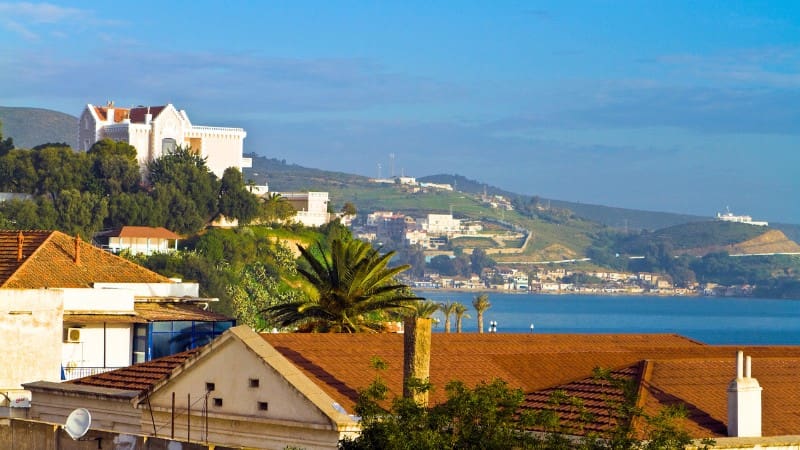
Let’s move on to Annaba, a city that’s right on the Mediterranean Sea. It’s a place where you can dip your toes in the ocean in the morning and explore ancient ruins in the afternoon. Annaba has been around for a really long time – more than 2,000 years!
Here’s a table that shows some fun things to do in Annaba:
| Activity | Where to Do It | What You Need | Best Time to Go |
|---|---|---|---|
| Explore Roman Ruins | Hippo Regius | Comfortable shoes, water | Morning (before it gets hot) |
| Visit the Basilica | Hill of St. Augustine | Camera for great views | Late afternoon for sunset |
| Swim at the Beach | Plage Chapuis | Swimsuit, sunscreen | Midday for warmest water |
| Try Windsurfing | Plage Chapuis | Rent equipment at beach | When it’s windy (usually afternoon) |
| Eat Seafood | Restaurants near beach | Hungry stomach! | Dinner time for freshest fish |
Walk Through Ruins of Hippo Regius
Just outside Annaba, there’s an old Roman city called Hippo Regius. Don’t worry, it has nothing to do with hippos! The name comes from an old Phoenician word. This city was a big deal back in Roman times, and you can still see a lot of what’s left.
When you visit Hippo Regius, you’ll see the remains of big houses, temples, and even a theatre where Romans used to watch plays. One of the neatest things in Hippo Regius is the public baths. Romans loved taking baths, and these were like ancient swimming pools where people would hang out and gossip.
The coolest part about Hippo Regius is that a famous guy named Saint Augustine lived here. He was a bishop and a writer, and people still read his books today. You can see the ruins of the church where he used to preach.
Visit the Big Church of St. Augustine
Speaking of Saint Augustine, there’s a huge church in Annaba built in his honor called the Basilica of St. Augustine, and it sits on top of a hill overlooking the city. The church is pretty new compared to the Roman ruins – it was finished in 1900.
The basilica is really big and beautiful because they’re built in a style that mixes Roman and Byzantine architecture, which means it has big domes and arches. Inside, there are colorful stained glass windows that tell stories from Saint Augustine’s life.
If you climb to the top of the hill where the basilica is, you get an amazing view of Annaba and the sea. On a clear day, you can see for miles! It’s a great place to watch the sunset.
Have Fun at Plage Chapuis Beach
After all that history, you might want to relax a bit. Luckily, Annaba has some great beaches! The most popular beach in Annaba is called Plage Chapuis, which is a long stretch of sand with clear blue water that’s perfect for swimming.
At the beach, you can do all sorts of fun stuff. You can build sandcastles, play beach volleyball, or just lie in the sun and read a book. If you’re feeling adventurous, you can try windsurfing or jet skiing. There are places where you can rent equipment and even take lessons.
When you get hungry, there are lots of little restaurants near Plage Chapuis beach where you can get yummy seafood. Try the grilled sardines – they’re a local specialty and they’re delicious!
10. Tipaza: Roman City Next to the Sea
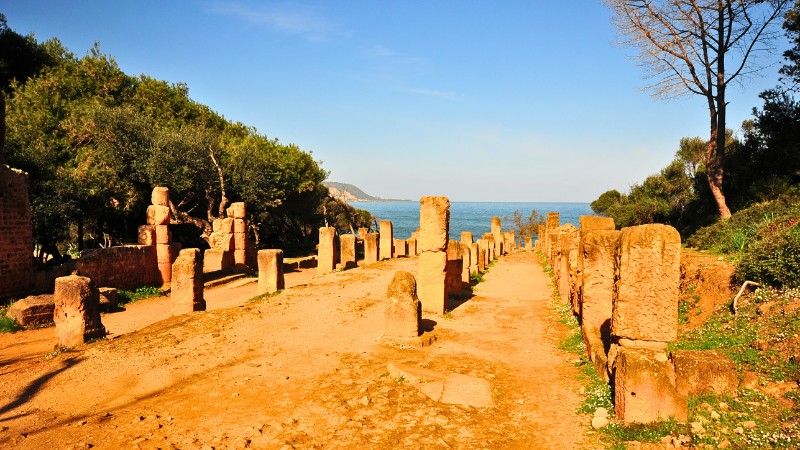
Our next stop is Tipaza, another destination to visit in Algeria where you can see amazing Roman ruins right next to beautiful beaches. Tipaza is special because it shows how the Romans, early Christians, and indigenous Berber people all lived in the same place over time.
Here’s a table showing some of the great things about Tipaza:
| Attraction | What You’ll See | Why It’s Special | When It Was Built |
|---|---|---|---|
| Roman Theatre | Semicircular seating area | Good acoustics, sea view | Around 200 AD |
| Great Christian Basilica | Ruins of big church | Shows spread of Christianity | 4th century AD |
| Roman Houses | Remains of villas | Mosaic floors still visible | 2nd-3rd century AD |
| Royal Mausoleum | Big round tomb | Built for ancient royalty | Around 3 BC |
| Beach Restaurants | Fresh seafood | Eat with view of ruins and sea | Modern day |
Explore Old Roman Buildings by the Water
The ruins at Tipaza are spread out over a big area right next to the Mediterranean Sea. As you walk around, you’ll see the remains of houses, temples, and a big amphitheatre where Romans used to watch gladiator fights. It’s pretty amazing to think about people doing these things in the same spot where you’re standing, over 2,000 years ago!
Tipaza is one of the best places to visit in Algeria because of its old Roman roads. You can still see the wheel ruts from ancient carts in the stone! There’s also a big cemetery with these things called sarcophagi, which are like stone coffins decorated with carvings.
The best part about Tipaza is how close it is to the sea. You can walk from ancient ruins right onto a beautiful beach. It’s a weird but awesome feeling to be swimming in the same waters that Roman ships sailed through long ago.
See the Royal Mausoleum Nearby
Not far from Tipaza, there’s a really interesting building called the Royal Mausoleum of Mauretania. It’s this big round tomb that was built for an ancient king and queen. The building is huge – about 60 meters across and 40 meters tall.
The Royal Mausoleum of Mauretania looks a bit like a giant cupcake sitting on top of a hill. It has 60 columns around the outside and used to be decorated with statues. Even though it’s really old (built around 3 BC), a lot of it still stands.
Sadly, you can’t go inside the mausoleum, but just seeing it from the outside is pretty impressive. The view from up there is amazing too – you can see for miles around!
Eat Yummy Seafood on the Beach
After all that walking around ruins, you’ll probably be hungry. Luckily, Tipaza has some great restaurants right on the beach. Because Tipaza is a coastal town, seafood is the big thing here.
You’ve got to try the grilled fish – it’s caught fresh every day and cooked right there on the beach. Another local favorite is seafood couscous, which is like tiny pasta with a mix of different seafood on top.
If you’re feeling brave, you might want to try sea urchins. They’re these spiky little creatures that live in the sea. People here crack them open and eat the insides raw. It might sound bizarre, but lots of people think they’re delicious!
11. Tlemcen: City of Beautiful Mosques
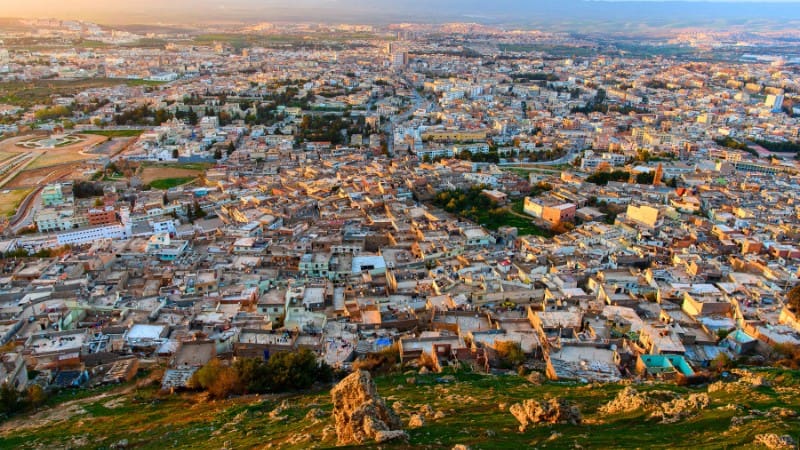
Let’s head to Tlemcen, a city west of Algeria, famous for its gorgeous mosques and interesting history. Tlemcen is like a big history book that you can walk through. It has buildings from different times—some are really old, and others are newer but still pretty neat.
Here’s a table that shows some cool things about Tlemcen:
| Place | When It Was Built | What’s Special | Best Time to Visit |
|---|---|---|---|
| Great Mosque | 1082 | Beautiful carvings and tiles | During non-prayer times |
| Mansourah Ruins | 1303 | Tall minaret, old city walls | Morning for good light |
| El Ourit Waterfall | Natural | 30m high waterfall | Spring for most water |
| Mechouar Palace | 1248 | Old royal palace, now a museum | Afternoon to avoid crowds |
| Sidi Boumediene Complex | 1197 | Tomb of famous saint, nice view | Friday to see locals visit |
Look at the Amazing Great Mosque
The Great Mosque of Tlemcen is a must-see when you’re in the city. It’s super old – they started building it way back in 1082! The mosque is huge and has lots of pretty decorations inside and outside.
When you go inside, look up at the ceiling. It’s covered in these beautiful patterns that look like lace made of wood. The people who made it were really good at carving. There’s also a tall tower called a minaret. It’s 40 meters high, which is about as tall as a 13-story building!
One cool thing about this mosque is that it has a special room called a mihrab. This room shows which way Mecca is, and it’s extra fancy. The walls are covered in tiny pieces of colorful tiles that make pretty patterns. It’s like a giant, sparkly puzzle on the wall!
Explore the Broken City of Mansourah
Just outside Tlemcen, there’s a place called Mansourah. It was supposed to be a big, important city, but it was never finished. Now, it’s like a giant puzzle with lots of pieces missing.
The main thing to see in Mansourah is the big mosque. Well, what’s left of it anyway. The mosque’s minaret is still standing, and it’s really tall – about 48 meters high. That’s taller than the one in Tlemcen! Even though a lot of the mosque is broken, you can still see how grand it used to be.
Walking around Mansourah feels a bit like being in a fairy tale. There are old walls and gates, and you can imagine what it might have looked like if they had finished building everything. It’s a great place to play pretend and think about what life was like hundreds of years ago.
Visit a Cool Waterfall Nearby
If you’re tired of looking at old buildings, don’t worry! Near Tlemcen, there’s a beautiful waterfall called El Ourit. It’s in a place called the Tlemcen National Park, which is full of trees and plants.
The waterfall in Tlemcen National Park is about 30 meters high, and the water comes down in lots of little streams. It looks like a curtain made of water! The best time to see it is in spring when there’s more water. In summer, it can get a bit dry.
Around the waterfall, there are paths where you can walk and have a picnic. If you’re quiet, you might see some animals like monkeys or wild boars. Just remember not to feed them – they need to find their own food to stay wild and healthy.
12. El Oued: City with Many Domes

Now, let’s go to one of the top places to visit in Algeria that’s totally different – El Oued. This city is way out in the Sahara Desert, and it’s known as the “City of a Thousand Domes.” Can you guess why? Yep, there are lots and lots of domes!
Here’s a table showing some fun things about El Oued:
| Thing to Do | What It Is | Why It’s Cool | When to Do It |
|---|---|---|---|
| See the Domes | Walk around the city | Unique architecture | Early morning or late afternoon |
| Shop at Souk Libya | Visit the big market | Buy local crafts and food | Morning when it’s cooler |
| Watch Carpet Weaving | Visit a carpet shop | See how rugs are made | Anytime shops are open |
| Climb Sand Dunes | Play on big sand hills | Fun views, exciting to slide down | Sunrise or sunset for best views |
| Try Local Dates | Eat fresh dates | Taste test different kinds | Anytime – they’re always yummy! |
See Houses with Round Roofs
In El Oued, almost all the buildings have round, dome-shaped roofs. From above, the city looks like it’s covered in upside-down bowls! There’s a good reason for this – the domes help keep the houses cool when it’s super hot outside.
The domes are made of brick and covered in plaster. They’re painted white to reflect the sun. Inside the houses, the domes make the rooms feel bigger and airier.
Walking through the streets of El Oued is fun because every building looks a bit different. Some domes are big, some are small, and some buildings have lots of little domes all in a row.
Buy Things at Old-Style Markets
El Oued has some really neat markets where you can buy all sorts of things. The biggest one is called the Souk Libya. It’s a covered market, which means it has a roof to keep out the hot sun. Inside, it’s like a maze of little shops and stalls.
One thing El Oued is famous for is its carpets. The women of Algeria here make beautiful rugs with bright colors and interesting patterns. Each carpet tells a story with its design. You can watch the women weaving if you visit a carpet shop.
Play on Big Sand Hills Nearby
Just outside El Oued, there are huge sand dunes. These are like giant hills made of sand, and they’re really fun to play on. Some of them are over 100 meters high! That’s as tall as a 30-story building.
You can climb up the dunes (it’s harder than it looks!) and then run or roll down. Some people bring cardboard to slide down on, like sledding, but on sand instead of snow.
If you visit the dunes at sunrise or sunset, you’ll see an amazing sight. The sun makes the sand look orange and red, and the shadows of the dunes stretch out really long. It’s a great time to take photos or just sit and enjoy the view.
13. Batna: City Near Very Old Places
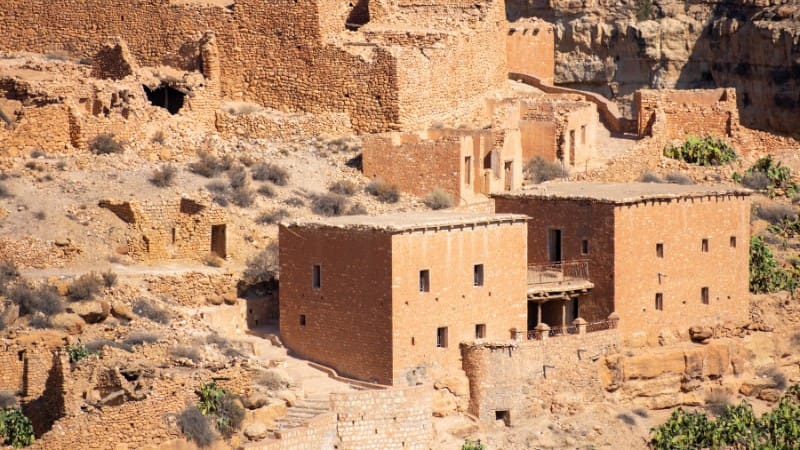
Batna is a city that’s like a doorway to some of Algeria’s oldest and most interesting places. Batna itself is pretty new – it was only founded in 1844 – but the areas around it are super old. This city is a great place to stay if you want to explore ancient ruins and beautiful mountains.
Here’s a table showing some of the cool things you can see and do around Batna:
| Place | What It Is | What You Can See | Best Time to Visit |
|---|---|---|---|
| Timgad | Roman ruins | Whole Roman city layout | Spring or Fall (not too hot) |
| Lambaesis | Roman military camp | Big arch, temple ruins | Morning for good light |
| Batna Museum | History museum | Roman artifacts, mosaics | Anytime (it’s indoors) |
| Aures Mountains | Mountain range | Forests, wildlife, views | Summer for warm weather |
| Ghoufi Balconies | Canyon viewpoints | Amazing rock formations | Late afternoon for best photos |
Visit the Roman Cities of Timgad and Lambaesis
Near Batna, there are two amazing old Roman cities you can visit. The first one is Timgad, which we talked about earlier.
The other city is called Lambaesis. It’s not as well-known as Timgad, but it’s still really neat. Lambaesis used to be a Roman military camp. You can see the remains of a big arch that was the entrance to the camp, and there’s a temple that’s still standing after all these years.
Both of these places show how the Romans lived in North Africa. It’s weird to think that people so long ago had houses, shops, and even public toilets, just like we do today. When you visit, try to imagine what it would be like to live there back then.
See Old Things in the Batna Museum
After you’ve walked around the ruins, you might want to learn more about the stuff you saw. That’s where the Batna Museum comes in handy. It’s full of things that were found in Timgad, Lambaesis, and other old sites nearby.
In the Batna Museum, you can see old coins, pottery, and even jewelry that people wore thousands of years ago. There are statues of Roman gods and emperors and lots of mosaics. The Romans were really good at making mosaics.
One of the coolest things in the museum is a big stone with writing on it. It’s called the Tariff of Timgad, and it’s like an ancient price list. It shows how much different things cost back in Roman times. Imagine being able to see how much a loaf of bread cost 1,800 years ago!
Enjoy Nature in the Aures Mountains
Batna is also close to some beautiful mountains called the Aures. These mountains are home to the Chaoui people, who have lived there for thousands of years.
In the Aures Mountains, you can go hiking and see some amazing views. There are forests of cedar trees that smell really good, and in some places, you can see snow in the winter. It’s hard to believe you’re in the same country as the hot Sahara Desert!
If you’re lucky, you might see some of the animals that live in the mountains. There are jackals (which are like wild dogs), porcupines, and even a type of sheep called a Barbary sheep.
14. Bejaia: Pretty City on the Coast
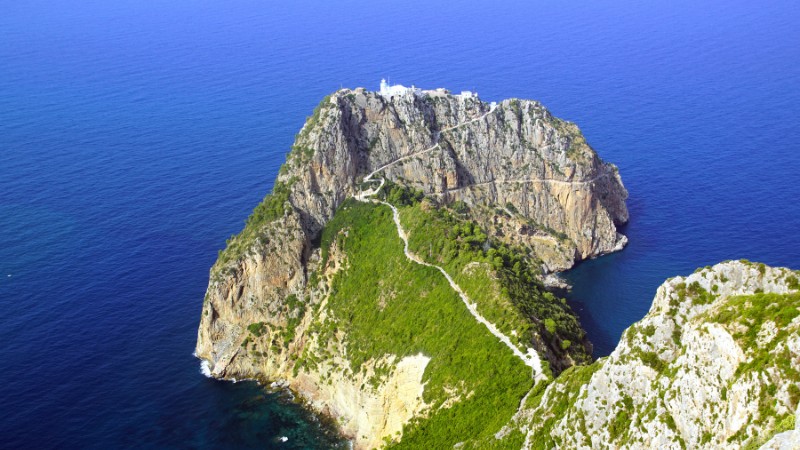
Our last stop is Bejaia, a beautiful city right on the Mediterranean coast. Bejaia has a bit of everything – beaches, mountains, and lots of history. It’s been an important city for a really long time, and lots of different people have lived there over the years.
Here’s a table showing some fun things to do in Bejaia:
| Activity | Where to Do It | What You Need | Best Time to Go |
|---|---|---|---|
| Hike Gouraya Mountain | Gouraya National Park | Good shoes, water, snacks | Early morning (cooler) |
| See Barbary Macaques | Cap Carbon (Monkey Peak) | Camera, binoculars | Midday (monkeys are active) |
| Visit the Lighthouse | Cap Carbon | Camera for great views | Late afternoon for sunset |
| Swim at the Beach | Tighremt Beach | Swimsuit, sunscreen | Midday for warmest water |
| Try Local Sardines | Restaurants near beach | Hungry stomach! | Dinner time for freshest fish |
Climb the Big Gouraya Mountain
Right next to Bejaia is a big mountain called Gouraya, which is part of a national park and a great place to go hiking. The mountain is 660 meters high, and it is about as tall as two Eiffel Towers stacked on top of each other!
When you climb Gouraya, you get amazing views of the city and the sea. On a clear day, you can see for miles and miles. The hike can be a bit tough, but it’s worth it when you get to the top. Don’t forget to bring water and snacks!
At the top of the mountain, there’s an old fort called Fort Gouraya. It was built way back in 1833 by the French. From up there, you can see why they chose that spot – you can see everything that’s happening in the area.
See Monkeys at Monkey Peak
Near Bejaia, there’s a place called Cap Carbon, but most people call it Monkey Peak. Can you guess why? Yep, there are monkeys there! These monkeys are called Barbary macaques, and they’re the only monkeys that live in North Africa.
The monkeys at Monkey Peak are wild, but they’re used to seeing people. You might see them playing, eating, or just sitting in the sun. Remember, even though they might look friendly, it’s important not to feed them or try to touch them. They’re still wild animals, after all.
Besides the monkeys, Cap Carbon is famous for its lighthouse. It’s one of the highest lighthouses in the world, sitting on a cliff 220 meters above the sea. That’s higher than the Statue of Liberty!
Swim at Nice Beaches
After all that climbing and monkey-watching, you might want to relax at the beach. Bejaia has some really nice ones! The most popular is probably Tighremt Beach. It’s a long stretch of sand with clear blue water that’s perfect for swimming.
At Tighremt Beach, you can do all sorts of fun stuff. You can build sandcastles, play beach volleyball, snorkeling, or just lie in the sun and read a book. The water is so clear that you can see lots of colorful fish swimming around.
When you get hungry, there are lots of little restaurants near the beach where you can get yummy food. Try the sardines – Bejaia is famous for them. They’re usually grilled and served with a slice of lemon.
Practical Tips for Visiting Algeria in 2024
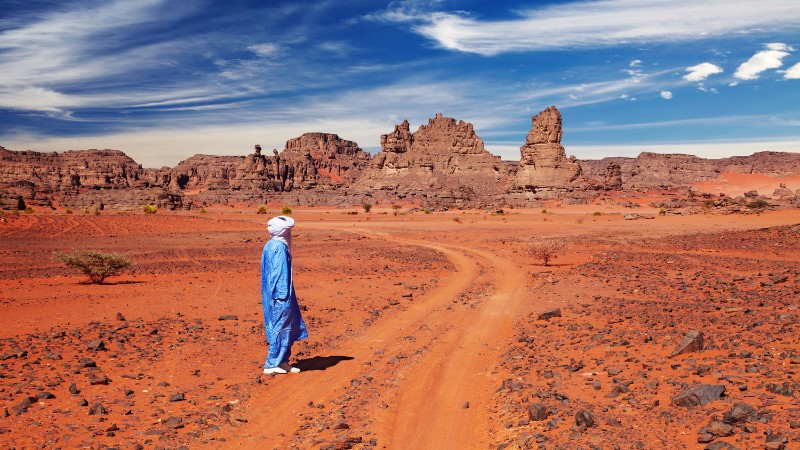
Now, it’s time to talk about some important things you need to know before visiting Algeria. Planning a trip to Algeria can be exciting, but there are a few things to keep in mind to make sure everything goes smoothly.
Algeria Visa Requirements and Entry Policies
Yes, you’ll need a visa to visit Algeria. It’s like a special permission slip to enter the country. Here’s what you need to know:
- Most people need to get their visas before they travel. You can’t just show up at the airport and expect to get in!
- To get a visa, you’ll need to fill out some forms and send them to the Algerian embassy in your country. You’ll also need to send your passport and some photos.
- Here’s a new thing for 2024: if you’re going to visit the Sahara Desert, you might be able to get a visa when you arrive. But you need to book your trip with a special travel agency first.
- Your passport needs to be valid for at least six months after your planned return date. So if you’re thinking about visiting, check your passport’s expiration date.
- Make sure you have a return ticket or proof that you’re going to leave Algeria. They want to know you’re not planning to stay forever.
Remember, rules can change, so it’s a good idea to check with the Algerian embassy or a travel agent before you make plans.
Algeria Transportation Options
Once you’re in Algeria, you’ll need to figure out how to get around. Here are some ways to travel:
- Planes: Algeria is a big country, so flying is a good way to cover long distances. There are airports in most big cities.
- Trains: There’s a train that runs along the coast between major cities. It’s slower than flying, but you get to see more of the countryside.
- Buses: For shorter trips, buses are a cheap and easy way to travel. They go to most towns and cities.
- Taxis: In cities, you can use taxis to get around. Make sure the driver uses the meter or agree on a price before you start the trip.
- Rental cars: You can rent a car, but be careful! Driving in Algeria can be tricky if you’re not used to it.
Be sure to keep these tips in mind, you’ll be all set for an amazing visit to Algeria. From the Roman ruins to the Sahara Desert, from busy cities to peaceful beaches, there’s so much to see and do. Just remember to be prepared, stay safe, and have fun!
For more travel guides, expert tips, and comprehensive information about amazing destinations worldwide, visit destination.com. Whether you’re planning a desert adventure, a city break, or a tropical getaway, we’ve got you covered with all the travel inspiration and practical advice you need!
What is the Famous Place in Algeria?
The most famous place in Algeria is the Casbah of Algiers. It’s a historic area with narrow streets, old houses, and notable landmarks like the Ketchaoua Mosque. This UNESCO World Heritage site showcases beautiful Moorish architecture and is full of history.
Which Month is Best to Visit Algeria?
The best time to visit Algeria is during spring (April to June) and fall (September to October). The weather is mild and pleasant, with temperatures between 15°C to 25°C (59°F to 77°F). This period also has less rainfall, making it ideal for sightseeing and outdoor activities.
Is Algeria Expensive to Visit?
Visiting Algeria is quite affordable. Budget travelers’ daily expenses are around $29, including accommodation, food, and transport. Meals at inexpensive restaurants cost about $2.50. Hotels are reasonably priced, with 3-star hotels averaging $88 per night. Public transport is cheap, with one-way tickets costing around $0.22.

